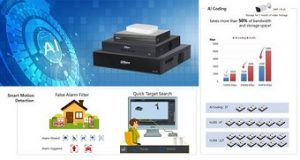
The accuracy and performance of video analytics has been hugely enhanced in recent years, thanks to deep learning, high-performance computing and big data analysis. And, wider adoption of AI – and deep learning in particular – is making video surveillance and detection even more accurate, while lowering costs. The effect is to speed up post-incident investigation by allowing searching and filtering based on criteria such as personal characteristics or types of object.
There is no doubt that video analytics driven by deep learning AI is becoming more common in video surveillance, whether on the periphery in cameras or at the core in NVRs/DVRs and in the cloud. Vendors – including Dahua Technology – now offer cameras and recording equipment with AI video analytics functionality. In fact, Dahua’s range of AI products has become so wide, that it is now bringing the technology to many more users by including it in entry-level products – such as the Cooper-I series range of XVR digital video recorders.
The Cooper-I series supports both H.264 and H.265 compression and comes with smart motion detection (SMD Plus) and AI Coding features. Dahua claims to be the only manufacturer that includes AI functionality in its entry-level digital video recorders, providing users with all the advanced capabilities of AI, but at a more cost-effective price.
SMD Plus – which is enabled by default without any additional configuration needed – promises to accurately identify people and vehicles while filtering out false alarms created by other objects, either in real-time or when searching recorded video. Using deep-learning algorithms – which analyse a scene intuitively by recognising objects and patterns like humans do, rather than just registering pixel changes – offers a dramatic increase in detection accuracy and a consequent reduction in false alarms.
Although offering users the potential for 4K ultra high definition images, there are potential drawbacks to the technology – such as theoretically needing four times the bandwidth and storage capacity – that increase the total cost of ownership. The AI Coding function of the Cooper-I series, however, saves more than 50% of bandwidth and storage space compared with only conventional H.264/H.265 coding. Combining the company’s HDCVI 6.0 Plus features with cutting-edge AI, Dahua delivers AI functionality for its complete HDCVI (HD over coax) range.
The growing use of video analytics and AI is confirmed in a 2020 report by Ifsec Global on video surveillance, which says that the overwhelming majority (71%) of security professionals now believe that analytics software has reached a point where it can provide real value to them. A small majority (54%) continue not to use analytics in their own surveillance systems, demonstrating that there is still a significant untapped market for analytics. The report also ranks the main reasons security professionals would invest in video analytics, top of which is the reduction in false alarms. This shows that false alarms continue to challenge the industry and finding methods to reduce them – such as implementing AI-based video analytics – is a major priority. An overwhelming majority of respondents to the survey (71%) said they now believed video analytics has reached a point where it can provide real value.
As we have seen, the accuracy and performance of video analytics has improved immeasurably in recent years, and users are embracing the technology in increasing numbers. This means that products such as Dahua’s Cooper-I series – with SMD Plus and AI coding functions – are set to contribute to the greater take-up of video analytics and AI, helping to satisfy the demand for advanced functionality at entry-level prices. It will be interesting to revisit this subject in a couple of years’ time to see how these products have contributed to the wider use of AI among security professionals











